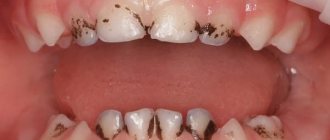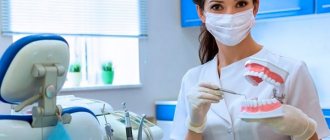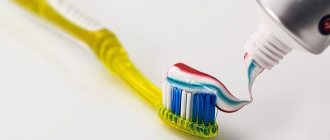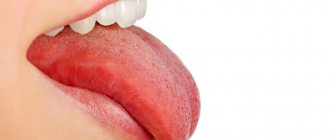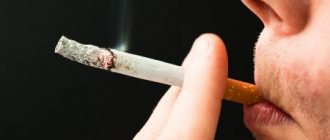05.10.2021 319
Patients often turn to dentists because they are faced with the problem of black plaque on their teeth. This greatly spoils the aesthetics of a smile, brings inconvenience, and stimulates the appearance of complexes and barriers to communication.
You also need to understand that black plaque on a tooth indicates serious problems in the body that need to be eliminated as soon as possible. Sometimes it can be accompanied by pain and bad breath.
In this material we will talk about what leads to the appearance of dark plaque and what methods dentists use to deal with it.
Why plaque and stone are dangerous
The plaque that settles on the teeth is soft. It can be easily removed with any hygiene products. Within 6-12 hours it reacts with the components of saliva, becomes saturated with calcium salts and hardens. The only way to prevent this is to use mouthwash throughout the day. Once the plaque has hardened, it can no longer be removed.
Tartar gradually forms. It continues to grow as new layers of plaque easily “stick” to the rough surface. After about 6 months it becomes visually noticeable, but this is not its main danger.
The stone grows in the cervical part of the crown, gradually penetrating into the subgingival area. This leads to mechanical damage to the gums and loosening of the teeth. Microorganisms cause gum inflammation and provoke more severe oral diseases. Patients complain of bleeding and sensitivity of the gums, and bad breath. With further growth of the stone deeper into the gums, there is a risk of developing cysts on the root of the tooth.
Reasons for the formation of black plaque
- Excessive smoking and coffee consumption. This reason is the most common . The substances contained have coloring properties. Penetrating into plaque, it darkens, hardens and almost attaches to the enamel, thereby forming tartar.
Nicotine resins, tea and coffee pigments provoke the rapid formation of such plaque, which is then quite difficult to clean.
- As a result of a serious illness or taking antibiotics over a long period of time. For example, black plaque occurs with problems with the liver, spleen, complications of viral infections.
- Work specifics. Blackening of teeth in the gum area is observed among workers in the metallurgical industry. This is due to the formation of condensate, which contains microparticles of heavy metals, which, when inhaled, deposit on the internal organs. This leads to poisoning, what can we say about the usual staining of plaque.
- In children, dysbacteriosis can provoke the appearance of plaque. A child's intestinal microflora is formed before the age of three. Therefore, there is no need to fall into a state of panic and enthusiastically begin to remove plaque from your teeth. Basically, the plaque disappears on its own after some time.
- Consumption of apples is a controversial issue. For the whole body and enamel in particular, it is useful to eat a couple of apples a day.
NOTE: when it’s out of season, fruits in the store are treated with harmful chemicals to ensure their safety. Thus, when you eat a large number of apples, you consume a large dose of formaldehyde and other harmful substances. In this case, do not be surprised that you have a black coating.
- Addiction. A destructive process occurs in all internal organs, including teeth. With this option, you can say goodbye to a healthy and beautiful smile.
Causes of congestion
- Insufficient oral hygiene, incorrectly selected hygiene products.
- Eating a lot of sweets, sticky foods, rich in light carbohydrates, and at the same time a small amount of solid foods, such as vegetables, in the diet.
- Abuse of products that have a coloring effect. Tea, coffee, cola, carbonated drinks - all this leads to the fact that the plaque turns brownish and, after hardening, spoils the smile.
- Diseases of internal organs. Patients with diseases of the gastrointestinal tract and endocrine system are prone to the formation of plaque on their teeth.
- Partial edentia, malocclusion, severe crowding of teeth.
Patients with bridge prostheses are at risk. The bridge is fixed on the supporting tooth. Food particles get trapped under the crown. In this case, cleaning plaque on teeth with conventional means is impossible. As a result, it grows, microorganisms attack the gums and supporting teeth, and it becomes mobile. If you have dentures, you should definitely visit your dentist for professional cleaning.
Prevention
As mentioned above, the source of its appearance can be smoking and frequent consumption of strong tea, coffee and other coloring drinks and foods. In this case, the prevention of the appearance of such plaque will be to refuse them. After all, plaque is not only an aesthetic defect, but also a source of pathogenic bacteria, as well as a fertile environment for their reproduction.
If you still cannot give up bad habits, diversify your diet with solid foods, especially high-fiber vegetables. Chewing them promotes daily natural cleaning of the enamel. At the same time, you should not refuse regular visits to the dental office, even if, upon a superficial examination in the mirror, it seems to you that everything is fine with your teeth.
Of course, timely and proper dental care is also a means of preventing the appearance of black plaque. Thus, the use of medicated fluoride-containing toothpastes, the use of dental floss and rinses can reduce the risk of plaque significantly.
Types of plaque
- Soft. Formed on teeth during human life. It is not noticeable on the surface of the enamel and is easily removed from it using hygiene products.
- Solid. Once hardened, it is almost impossible to remove plaque from teeth at home.
- Supragingival stone. Formed from hard plaque. Outwardly it looks like a small dark-colored rim in the cervical area.
- Subgingival stone. It is formed under the gum, so it is not visually noticeable. It can only be detected using a special dental probe or an x-ray. If subgingival stone is not removed in time, gum resection may occur.
Ways to get rid of black plaque at the dentist
Any dental problem should be addressed with a dentist. The resulting black plaque is no exception. Now there are many different techniques that allow you to clean very efficiently and without causing harm.
The most popular methods include:
1. Ultrasound. This is one of the most popular ways to combat dark plaque, because almost all dental clinics have acquired the appropriate apparatus. This procedure costs from 70 to 150 rubles per one. Using ultrasound, a specialist removes plaque and tartar that has hardened over many years without damaging the enamel. In this case, the patient does not feel pain. 2. Air Flow. This procedure involves the dentist removing soft plaque from the surface using a soda jet mechanism.
Among the disadvantages of this procedure are:
- Quickly disappearing effect (it lasts no more than six months)
- It is impossible to remove hard plaque and tartar.
- Weakened upper layers of enamel (after the procedure is completed, it is necessary to cover the tooth with protective paste).
- In some cases, sensitivity increases and the gums begin to bleed.
In order to more effectively remove black plaque, they simultaneously resort to the two above procedures. It will cost about 3,500 thousand rubles.
Ultrasonic cleaning + Air Flow in detail
3. Whitening with laser. The only disadvantage of the procedure is the price, which can be 30,000 rubles. The laser acts without pain and does not destroy the enamel. The laser will not cause bleeding gums. The effect of the procedure will be noticeable for four to five years.
If you systematically take care of your teeth and contact specialists in a timely manner, the described procedures will be able to return the natural color.
Black wisdom teeth deserve special attention. It has no functions: it does not play a role during chewing food. When the described problem occurs, it is easier to pull out this tooth than to treat it due to its inconvenient location and uselessness.
Home Remedies
Home remedies for plaque removal are rather preventative. In order to maintain dental health, it is necessary to follow the rules of hygiene:
- Brush your teeth twice a day with a toothbrush and suitable toothpaste.
- Use toothpicks and dental floss after meals, as the brush cannot reach hard-to-reach places.
- Use mouthwash regularly.
Small plaque can be removed using pastes containing abrasives or tooth powder. When using them you need to be careful, as you can damage not only the enamel, but also the mucous membrane of the gums. You need to be even more careful if you decide to remove plaque from your teeth with whitening agents - soda, hydrogen peroxide. Their uncontrolled use can cause problems with dental health.
How to remove plaque from teeth at home
To prevent plaque deposits, you must brush your teeth thoroughly every day. And after eating food, use dental floss. However, if the appearance of black plaque cannot be avoided, and a trip to the dentist is not planned, you can try using folk remedies.
Whitening toothpastes
Now in the pharmacy you can find special toothpastes against black plaque. They help remove plaque quickly. And some toothpastes are even capable of defeating small tartar.
However, before you buy a paste, you should definitely read its composition. There should be abrasives and other additional means that soften the plaque. It should also be understood that such pastes cannot be used for a long period. They can damage the enamel.
Attention! Abrasive substances are designated by the letters RDA.
Toothbrushes for removing plaque
In addition to toothpastes and other medications, there are special toothbrushes. There are several types:
- Ordinary manual ones.
We know such toothbrushes very well. This is a plastic stick with a brush. That's what it's all about. Brushes can be hard or soft. The latter should be used for sensitive gums. But the hard ones are ideal when there is a black residue on the toothbrush.
- Ultrasonic brushes.
These are modern products that operate on the basis of ultrasound. During operation, microwaves are created, which have a detrimental effect on plaque.
- Electric toothbrushes.
They work on the principle of rotational-translational and pulsating movements. The shock movements of the brush break up black plaque and stones.
In conclusion, it is worth noting that any problems can be prevented if you constantly monitor oral hygiene. But this may also not be enough, so it is recommended to visit the dentist 2-3 times a year.
Be healthy!
This article is for informational purposes only, please consult your doctor for details! Ask your doctor about contraindications and side effects.
Remove tartar from teeth and strengthen enamel - a set of 5 procedures!
- Ultrasound removal of tartar. The first thing a hygienist does is remove tartar. To do this, he uses an ultrasonic scaler that affects deposits with microvibrations. The process is accompanied by water pressure, which has a cooling effect, reduces discomfort and facilitates the removal of tartar. The procedure is practically painless, however, with increased sensitivity of the teeth, discomfort may occur. In this case, the doctor will give you local anesthesia.
- Removing plaque with air flow . A special device supplies an abrasive substance and water under high pressure. The sandblasting method has no contraindications. It does not damage enamel and gums. Soda crystals are used as an abrasive. Modern Air-flow kits may contain flavoring additives that make the procedure more enjoyable. After treatment with this tip, smoothness and natural color return, which is why the Air Flow method is often called whitening. But sandblasting does not replace ultrasonic cleaning, since it is not intended to remove tartar, which is why they are used in pairs.
- Therapeutic treatment of gums - for the purpose of prevention or in the presence of an inflammatory process, the gums are treated with a special disinfecting, soothing and regenerating solution.
- Polishing the surface of the teeth. After hard deposits are removed and plaque is removed, the surface of the teeth is polished using a special abrasive paste, which must be selected individually based on the characteristics of the patient’s enamel. Even if there are fillings, such treatment makes the surface of the tooth absolutely smooth, which prevents the accumulation of plaque.
- Fluoridation. At the end of the hygienic cleaning procedure, the teeth are coated with fluoride varnish to strengthen and prevent hypersensitivity. It envelops the tooth surface like a film. Keep in mind that domestically produced fluoride varnishes can give teeth a yellow tint.
Kinds
- Round. A universal option, suitable for use with both normal and large interdental gaps;
- Flat. Suitable for narrow spaces and in cases of missing teeth;
- Tape. Suitable for any interdental spaces, including significantly expanded ones;
- Volumetric. They have the ability to swell and significantly increase in size, which allows them to fill the interdental space as much as possible.
In addition to the cross-section, the threads differ in the impregnations applied to them. So there are threads with:
- Waxing. This type of thread is treated with wax, which facilitates sliding and increases the strength of the thread;
- Menthol impregnation. Mint impregnation freshens breath and leaves a pleasant aftertaste;
- Fluoridation. Such threads not only clean the space between the teeth, but are also an additional prevention of caries;
- Antiseptic impregnation. Chlorhexidine is most often used as an antiseptic to prevent infection.
Kinds
Stationary
The power of the supplied jet usually does not exceed 550 kPa. The most preferred pulsation frequency does not exceed 1200 pulsating emissions. The device is mounted on a wall or any horizontal surface.
Portable
Completely autonomous, battery-powered devices with a jet power of at least 520 kPa. As a rule, they have the possibility of stepwise adjustment of modes.
Flow irrigators
A fairly democratic and simple device that changes power using a mixer valve.
Mechanical irrigators
The intensity of the supplied jet is set by pumping up the pump by hand.
Comments
I had my teeth cleaned at the dentist for the first time in my life just a few months ago, and today I noticed that there was too much plaque again. How so??
Olga (02.09.2020 at 20:39) Reply to comment
- Dear Olga, the rate of plaque formation can be affected by the presence of chronic diseases, poor oral hygiene, smoking, consumption of “colored” foods and drinks, the presence of gingivitis and periodontitis. Sometimes the cause of the pathology is the unprofessionalism of the doctor, who poorly polished the surface of hard tissues at the final stage of cleaning. You should contact an experienced dental hygienist or dental therapist to understand the situation.
Editorial staff of the portal UltraSmile.ru (09/06/2020 at 09:15) Reply to comment
I have an “extended” tooth, but it has become darker than mine, the doctor explained that a change in color can occur over time. Is it possible, in addition to a crown, to achieve lightening of just such a tooth?
Mira (09.23.2020 at 07:15) Reply to comment
Tell me, if you have crowns in visible places and your own teeth, what is best to use for cleaning? That is, the listed products for home use are also suitable for cleaning crowns. Or is there something simpler for crowns, or vice versa more effective?
Inga (09.23.2020 at 09:00) Reply to comment
Tell me, which method of professional teeth cleaning is the safest and most gentle? And what is the most correct and effective method of home cleaning? I'm afraid of ruining the enamel.
Elena (09/23/2020 at 11:57 am) Reply to comment
We were surprised about the banana peel! I knew about fruit acids. I have increased sensitivity of all my teeth, because my gums have risen, if I express myself correctly, that is, the necks of my teeth have become slightly open. Visually it’s not very noticeable, but there is a reaction to sweet/sour. In my case, there’s probably no way to whiten my teeth at all? Thank you.
Victoria (09/23/2020 at 12:32 pm) Reply to comment
Twice a year I do ultrasonic teeth cleaning. The dentist advised me to buy an electric ultrasonic toothbrush. But I heard that electric brushes destroy teeth. Is it worth buying?
Zlata (11/20/2020 at 6:10 pm) Reply to comment
Hello, can you tell me how often I can do water-abrasive cleaning? If six months have not yet passed since the last procedure, and I am still not satisfied with the cleanliness of my teeth, can I repeat the procedure, or will frequent use harm my teeth?
Irina (11/20/2020 at 6:59 pm) Reply to comment
Doesn’t all this cleaning harm the enamel and make the teeth, although plaque-free, sensitive? I'm afraid to even do regular brushing; I think I could damage my teeth or wear away the enamel.
Sveta (11/20/2020 at 07:41 pm) Reply to comment
I don't smoke, but I still have plaque. I drink a lot of coffee, so they are yellow. I used to brush with baking soda instead of tooth powder. Then they told me that I shouldn’t do this often because it could erase the enamel.
Anna (11/20/2020 at 08:29 pm) Reply to comment
A high-quality paste will help you and it’s expensive, and after one brushing I also clean it with tooth powder. Those. twice a morning, for example. Well, you also don’t need to overdo it with cleaning, so that you don’t have a dry mouth later.
Marina (11/20/2020 at 09:08 pm) Reply to comment
Write your comment Cancel reply
How to floss
- A part with a length of 20 to 30 centimeters is separated from the total skein.
- A piece of thread is fixed between the fingers of two hands.
- The stretched thread is inserted between the teeth and lowered with smooth movements to the gums.
- Keeping the floss taut, make forward and backward movements.
- Each new gap requires the use of a new section of thread.
Having examined both oral care products in detail, we can draw conclusions about whether an irrigator can replace dental floss .
Bacterial plaque on teeth: causes
Soft or, as it is also called, bacterial plaque has a soft consistency, so it is easy to get rid of it with the help of an ordinary toothbrush. The main place of its accumulation is the neck of the teeth.
Harder plaque that cannot be removed with a brush is called tartar. It occurs during the mineralization of soft plaque with phosphorus and calcium salts present in saliva.
Why does plaque form?
There are constantly a huge number of bacteria in the mouth, which, firstly , multiply, and secondly , leave behind waste products. Even if you brush your teeth regularly, plaque cannot be avoided: within 6 hours after thorough brushing, you can easily notice, without resorting to the use of specialized equipment, a bacterial mass on the surface of the tooth enamel. A surge in microbial activity is observed immediately after eating: leftover food in the mouth forces bacteria to begin intensive processing.
At the same time, even small pieces of food that are invisible to the human eye are enough for microorganisms: they can feed on a film consisting of carbohydrates and proteins that invariably remains on the surface of the teeth after eating, and on food debris that gets into the spaces between the teeth. In this regard, it is imperative to brush your teeth for 15 minutes after each meal, since the mass of bacterial plaque can increase several times in volume in 1-2 hours. Plaque accumulates especially intensely on the necks of teeth in people who like to snack on a bun or something sweet between main meals.
Almost immediately after the soft plaque appears, the process of mineralization begins, as a result of which it gradually hardens. The period of primary mineralization (i.e., when the plaque, in simple terms, “sets” but still remains loose) is 10-15 hours. When the plaque finally hardens, its surface becomes ideal for the formation of deposits.
Types of tartar
Tartar consists of one third of organic substances (epithelial cells, microorganisms, proteins, etc.) and 2/3 of inorganic substances (mainly calcium salts).
Stones are divided into:
- supragingival, which, as you can guess from their designation, are located above the gum. They are easy to see with the naked eye and are dark yellow in color. Removing such deposits is quite simple.
- subgingival. During a routine examination, they cannot be noticed, but their presence can be assumed by the bluish tint of the gums and increased bleeding in this place. It is possible that pus may be released from the periodontal pocket.
The presence of subgingival stones is the first sign of periodontitis and the beginning of tissue destruction around the tooth. Only a dentist can detect stones located under the gum by probing the pockets. Removing subgingival stones takes a lot of time, so not every doctor will undertake such work.
